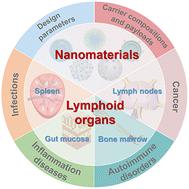当前位置:
X-MOL 学术
›
Chem. Soc. Rev.
›
论文详情
Our official English website, www.x-mol.net, welcomes your feedback! (Note: you will need to create a separate account there.)
Lymphoid organ-targeted nanomaterials for immunomodulation of cancer, inflammation, and beyond
Chemical Society Reviews ( IF 40.4 ) Pub Date : 2024-07-03 , DOI: 10.1039/d4cs00421c Jessica C. Hsu 1 , Peng Liu 1, 2, 3 , Yangmeihui Song 4, 5, 6 , Wenyu Song 1, 4, 5, 6 , Rachel J. Saladin 1 , Ying Peng 7 , Shuo Hu 2, 3 , Xiaoli Lan 4, 5, 6 , Weibo Cai 1
Chemical Society Reviews ( IF 40.4 ) Pub Date : 2024-07-03 , DOI: 10.1039/d4cs00421c Jessica C. Hsu 1 , Peng Liu 1, 2, 3 , Yangmeihui Song 4, 5, 6 , Wenyu Song 1, 4, 5, 6 , Rachel J. Saladin 1 , Ying Peng 7 , Shuo Hu 2, 3 , Xiaoli Lan 4, 5, 6 , Weibo Cai 1
Affiliation

|
Nanomaterials exhibit significant potential for stimulating immune responses, offering both local and systemic modulation across a variety of diseases. The lymphoid organs, such as the spleen and lymph nodes, are home to various immune cells, including monocytes and dendritic cells, which contribute to both the progression and prevention/treatment of diseases. Consequently, many nanomaterial formulations are being rationally designed to target these organs and engage with specific cell types, thereby inducing therapeutic and protective effects. In this review, we explore crucial cellular interactions and processes involved in immune regulation and highlight innovative nano-based immunomodulatory approaches. We outline essential considerations in nanomaterial design with an emphasis on their impact on biological interactions, targeting capabilities, and treatment efficacy. Through selected examples, we illustrate the strategic targeting of therapeutically active nanomaterials to lymphoid organs and the subsequent immunomodulation for infection resistance, inflammation suppression, self-antigen tolerance, and cancer immunotherapy. Additionally, we address current challenges, discuss emerging topics, and share our outlook on future developments in the field.
中文翻译:

用于癌症、炎症等免疫调节的淋巴器官靶向纳米材料
纳米材料在刺激免疫反应方面表现出巨大的潜力,可以对多种疾病提供局部和全身调节。脾脏和淋巴结等淋巴器官是各种免疫细胞的所在地,包括单核细胞和树突状细胞,它们有助于疾病的进展和预防/治疗。因此,许多纳米材料制剂正在合理设计以针对这些器官并与特定细胞类型结合,从而产生治疗和保护作用。在这篇综述中,我们探讨了免疫调节中涉及的关键细胞相互作用和过程,并重点介绍了基于纳米的创新免疫调节方法。我们概述了纳米材料设计的基本考虑因素,重点关注它们对生物相互作用、靶向能力和治疗功效的影响。通过选定的例子,我们说明了治疗活性纳米材料对淋巴器官的战略靶向以及随后的免疫调节以实现感染抵抗、炎症抑制、自身抗原耐受和癌症免疫治疗。此外,我们还应对当前的挑战,讨论新兴主题,并分享我们对该领域未来发展的展望。
更新日期:2024-07-03
中文翻译:

用于癌症、炎症等免疫调节的淋巴器官靶向纳米材料
纳米材料在刺激免疫反应方面表现出巨大的潜力,可以对多种疾病提供局部和全身调节。脾脏和淋巴结等淋巴器官是各种免疫细胞的所在地,包括单核细胞和树突状细胞,它们有助于疾病的进展和预防/治疗。因此,许多纳米材料制剂正在合理设计以针对这些器官并与特定细胞类型结合,从而产生治疗和保护作用。在这篇综述中,我们探讨了免疫调节中涉及的关键细胞相互作用和过程,并重点介绍了基于纳米的创新免疫调节方法。我们概述了纳米材料设计的基本考虑因素,重点关注它们对生物相互作用、靶向能力和治疗功效的影响。通过选定的例子,我们说明了治疗活性纳米材料对淋巴器官的战略靶向以及随后的免疫调节以实现感染抵抗、炎症抑制、自身抗原耐受和癌症免疫治疗。此外,我们还应对当前的挑战,讨论新兴主题,并分享我们对该领域未来发展的展望。











































 京公网安备 11010802027423号
京公网安备 11010802027423号